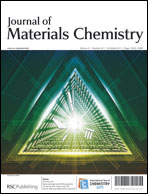The pre-modification method provides a rapid and controllable amount of biomolecule conjugated to nanomaterials via quantitative creation of “activated sites” on biomolecules, modulating specific targeting rate toward cancer cells. In our studies, activating reagent, 2-iminothiolane, is introduced into the biomolecule structure as activated site for linking to Au nanomaterial. To fabricate Au-based magnetic nanoparticles, the amounts of Au nanoparticles are controllably conjugated to chitosan–Fe3O4 nanoparticles by increasing activated sites on chitosan, adjusted by 2-iminothiolane concentration. Further, to develop the biorecognition of Au–Fe3O4 nanoparticles toward target cells, pre-modified transferrin (Tf) is allowed to facilitate the conjugation with Au–Fe3O4 nanoparticles, and validations of bioactivity and specificity are examined in vitro using J5 cancer cells as well. The cell uptake analysis indicates that the high-degree Tf modified Au–Fe3O4 nanoparticles have rapid-targeting ability and easy internalization toward cancer cell, compared to low-degree ones. It implies that the efficiency of cell targeting can be improved or lowered by modulating Tf modification. The potential control of applications can be achieved by modulating Tf modification, such as rapid-targeting rate for signal enhancement, the long-term or rapid drug-treatment in circulation, etc. This concept of modulating by Tf modification can be extensively utilized in future designs of various biomolecule-conjugated Au-based nanomaterials.

You have access to this article
 Please wait while we load your content...
Something went wrong. Try again?
Please wait while we load your content...
Something went wrong. Try again?


 Please wait while we load your content...
Please wait while we load your content...